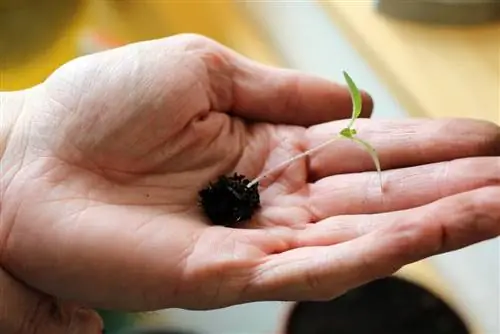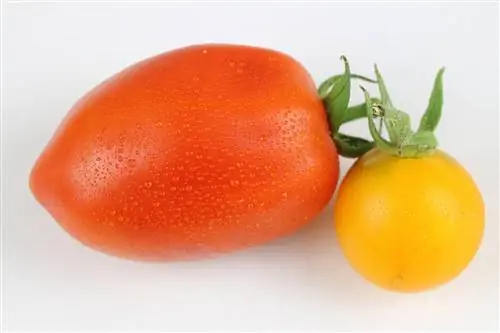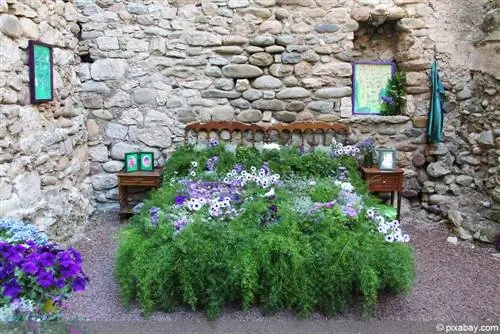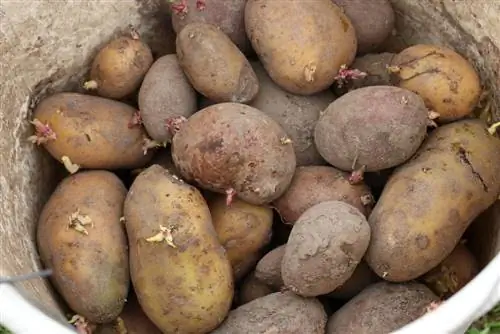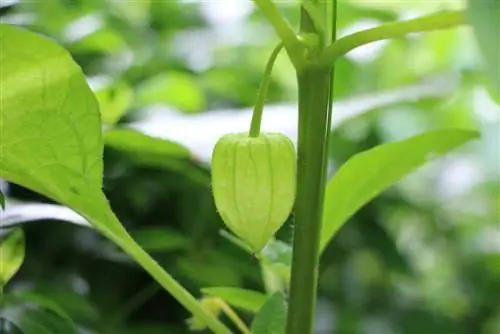- Author admin [email protected].
- Public 2023-12-17 03:39.
- Last modified 2025-01-24 12:45.
Many hobby gardeners reach their limits when cultivating exotic vegetables because the plants are not adapted to the conditions in Central Europe. They cannot survive the cold temperatures and require a long warm period for high harvest yields or successful fruit development. Pre-cultivation is a suitable method for growing slow-growing or heat-requiring plants in the garden.
Advantages of pre-cultivation
By pre-cultivating seeds in the pot, you can grow robust young plants using simple means. This method is cheaper than buying young plants from the garden store. The harvest is usually higher because the plants grow under controlled conditions. Depending on the type of plant, you can prefer seeds in a heated greenhouse, in a pot or in a cold frame. You benefit from a longer harvest period and achieve a larger selection of vegetables in your home garden.
Avoid stress
Freshly grown young plants from the specialist market were grown under special conditions. Frequent changes of location are necessary for transport and later display in the garden center, which inhibits the growth of the plants. If you choose young plants from seeds yourself, you will save the plants a lot of stress. They spend the important growing phase in the pot in a warm location with consistent conditions. Once they reach a certain size, the seedlings are planted in their final location so that they can finally get used to it.
Prefer in cold frame
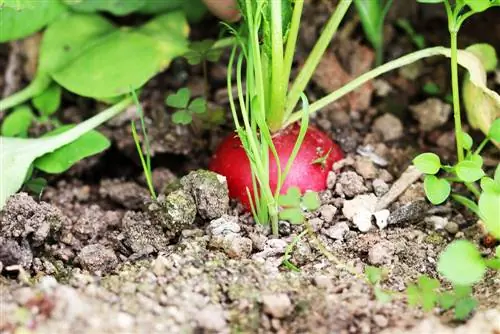
Some vegetables can be preferred despite their cold tolerance. This means you benefit from an earlier harvest because the early seedlings are ready for harvest more quickly than the individuals sown directly outdoors. However, you should cultivate these species in cool conditions in the cold frame, because if the temperatures are too warm the seedlings will begin to sprout. They develop long shoot axes that are unstable and bend easily. These plants do not feel comfortable in the nursery pot on the windowsill:
- Radish and carrots
- Beans and peas
- Radish and beetroot
Cultivate heat-requiring plants
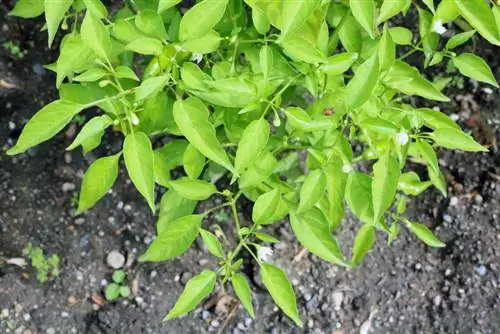
There are some vegetables that require particular heat. These plants have a long growing season, during which temperatures must be in the comfortable double digits. Cold damages the young plants significantly. Many vegetables do not survive late frosts in the early phase. To extend the frost-free growing time, you should grow the seeds in a pot according to the instructions and place it on a warm windowsill. You can pre-cultivate these plants as early as February or March:
- Chili and eggplant
- Tomatoes and peppers
- Zucchini and cucumbers
- Melons and pumpkins
Tip:
Plant the seedlings outdoors after the Ice Saints in mid-May. After that, the risk of late frosts is reduced significantly.
Natural heating in the cold frame
If space in the house is tight and you still prefer vegetables that need heat, you can create a natural heater for the cold frame with just a few resources:
- Dig the soil 40 centimeters deep
- Fill in 20 centimeters of horse manure, straw and leaves
- Fill the pit with potting soil
- sow seeds directly after a week
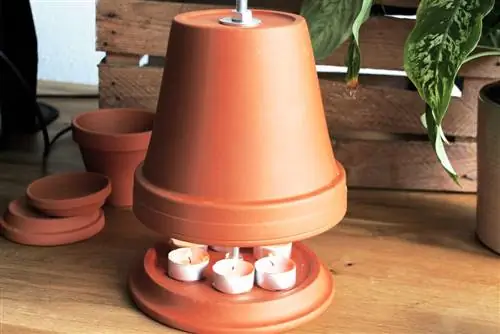
Horse manure is rich in nitrogen and is decomposed by soil organisms. The microorganisms produce heat that is radiated upwards. The closed cold frame retains the heat. Even if there is still snow around the cold frame, this natural heating works ideally. However, there should be no more severe frosts. As soon as the sun melts the snow, you should ventilate the cold frame regularly. This will prevent heat build-up.
Use nutrient-poor soil
In order for he althy plants to develop from the seeds, the substrate must not be too nutrient-rich. Under optimal site conditions, the seedlings are encouraged to develop strong roots if the soil is particularly poor in nutrients. They have to search for nutrients and form long roots. In a nutrient-rich substrate, the roots find enough nutrients in the immediate vicinity so that root development stops. Instead, the plants grow tall and rot. Therefore, use special potting soil.
Tip:
Use a nutrient-poor coconut fiber substrate for growing. The fibers swell in the water bath and store the moisture so that the seeds have optimal conditions for germination.
Note timing
In order for the seeds to germinate successfully, they need not only the optimal temperature but also high humidity. The incidence of light is just as important, because without sun the metabolism of the young plants does not work. Therefore, you should not start advancing too early. Even if you can ensure high humidity and warm temperatures in the heated greenhouse, the plants will lack light in January. As a result, the seedlings rot. In search of light, they develop long and thin shoot axes and bend over. With plant lamps in the greenhouse you can ensure better starting conditions for the seedlings. However, natural sunlight is better. You can often find information about when to sow in the instructions on the seed bags.
Tip:
Vegetable varieties with a long germination period can be sown from mid-February. Seeds that germinate quickly should only be brought forward from March onwards.
Protection from snail damage
By pre-cultivating in a pot, you protect particularly sensitive young plants from voracious pests. In the damp and cool spring, snails prefer to attack the tender leaves of lettuces. Even in cold frames and greenhouses, the young plants are not safe, which is why you should prefer these leaf lettuce varieties in pots:
- Lettuce and iceberg lettuce
- Batavia
- Asian salads
- Red lettuce
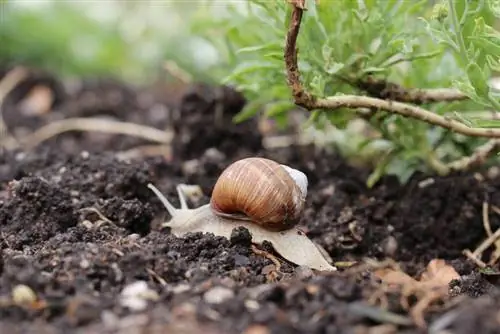
Pre-cultivation is possible from February. The seedlings can develop undisturbed on the windowsill, giving them a head start over plants that are sown directly into the cold soil outdoors. Since leaf lettuce is tolerant of cold, the already vigorously developed young plants can usually be placed outdoors from April onwards. Due to pre-cultivation, the lettuce plants are ready for harvest much earlier.
Prick in time
When the seedlings have developed the first real pair of leaves above the cotyledons, they are separated. If you miss this point, the roots of the neighboring plants will grow into each other and division will become increasingly difficult. The competition for light, nutrients and water is increasing, so that the seedlings can no longer grow optimally as the growing container becomes more crowded. You can easily remove the plants from the substrate using sticks, ice cream sticks, spoons or pencils:
- Slightly moisten the substrate
- Pry young plants out of the substrate with the stick
- carefully hold on to the leaves
- Avoid injuries to the shoot axis
- Place roots in the prepared planting hole
For the next growth stage, plastic pots with a diameter of around eight centimeters are sufficient. You should also use nutrient-poor growing substrate here to stimulate further root growth. You can save yourself the trouble of pricking out if you prefer the seeds in swelling tablets. The young plants are only placed in small pots when the tablet has completely rooted. With this method you also prevent root injuries that often occur when pricking out.
Note:
Chili, peppers, leeks and tomatoes should be planted in the soil up to the cotyledons. Other plants are planted at the same depth as they were previously in the growing container.

